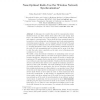901 search results - page 129 / 181 » Minimum power configuration in wireless sensor networks |
ALGOSENSORS
2009
Springer
14 years 3 months ago
2009
Springer
In this paper we consider the model of communication where wireless devices can either switch their radios off to save energy (and hence, can neither send nor receive messages), o...
NETWORK
2006
13 years 8 months ago
2006
Wireless sensor networks are built upon a shared medium that makes it easy for adversaries to conduct radio interference, or jamming, attacks that effectively cause a denial of se...
IAJIT
2010
13 years 7 months ago
2010
: Research on Wireless Sensor Networks has often assumed homogeneous nodes. In reality, homogeneous nodes have different capabilities like different levels of initial energy and dr...
IPSN
2007
Springer
14 years 2 months ago
2007
Springer
We introduce a novel laser spectroscopic trace-gas sensor platform, LaserSPECks that integrates recently developed miniature quartz-enhanced photoacoustic spectroscopy (QEPAS) gas...
ICC
2007
IEEE
14 years 3 months ago
2007
IEEE
—Since the provision of both unicast and multicast services is expected for the next generation of multi-carrier wireless systems, the allocation of resources for this combinatio...

